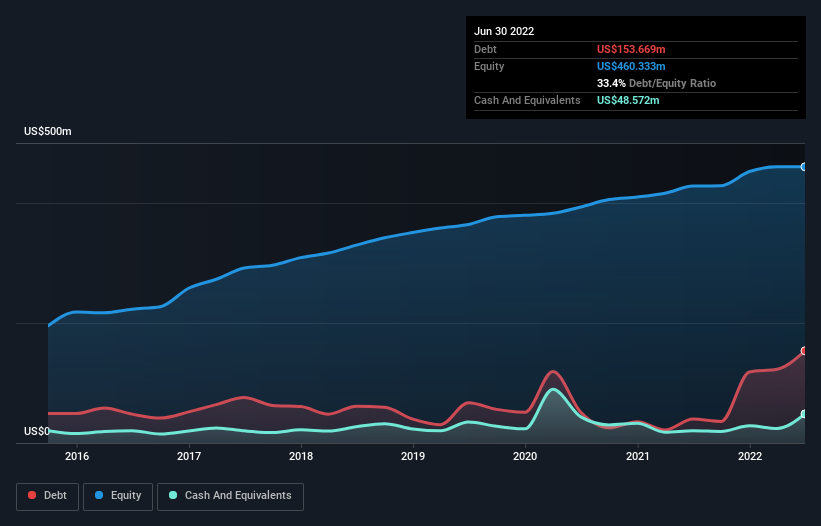- United States
- /
- Healthcare Services
- /
- NYSE:USPH
We Think U.S. Physical Therapy (NYSE:USPH) Can Stay On Top Of Its Debt

David Iben put it well when he said, 'Volatility is not a risk we care about. What we care about is avoiding the permanent loss of capital.' So it might be obvious that you need to consider debt, when you think about how risky any given stock is, because too much debt can sink a company. We can see that U.S. Physical Therapy, Inc. (NYSE:USPH) does use debt in its business. But should shareholders be worried about its use of debt?
When Is Debt Dangerous?
Generally speaking, debt only becomes a real problem when a company can't easily pay it off, either by raising capital or with its own cash flow. Part and parcel of capitalism is the process of 'creative destruction' where failed businesses are mercilessly liquidated by their bankers. However, a more frequent (but still costly) occurrence is where a company must issue shares at bargain-basement prices, permanently diluting shareholders, just to shore up its balance sheet. Of course, debt can be an important tool in businesses, particularly capital heavy businesses. When we examine debt levels, we first consider both cash and debt levels, together.
See our latest analysis for U.S. Physical Therapy
How Much Debt Does U.S. Physical Therapy Carry?
You can click the graphic below for the historical numbers, but it shows that as of June 2022 U.S. Physical Therapy had US$153.7m of debt, an increase on US$39.8m, over one year. However, it also had US$48.6m in cash, and so its net debt is US$105.1m.

How Healthy Is U.S. Physical Therapy's Balance Sheet?
The latest balance sheet data shows that U.S. Physical Therapy had liabilities of US$85.1m due within a year, and liabilities of US$251.0m falling due after that. Offsetting these obligations, it had cash of US$48.6m as well as receivables valued at US$69.5m due within 12 months. So its liabilities total US$218.1m more than the combination of its cash and short-term receivables.
This deficit isn't so bad because U.S. Physical Therapy is worth US$1.04b, and thus could probably raise enough capital to shore up its balance sheet, if the need arose. But it's clear that we should definitely closely examine whether it can manage its debt without dilution.
In order to size up a company's debt relative to its earnings, we calculate its net debt divided by its earnings before interest, tax, depreciation, and amortization (EBITDA) and its earnings before interest and tax (EBIT) divided by its interest expense (its interest cover). The advantage of this approach is that we take into account both the absolute quantum of debt (with net debt to EBITDA) and the actual interest expenses associated with that debt (with its interest cover ratio).
U.S. Physical Therapy has a low net debt to EBITDA ratio of only 1.3. And its EBIT easily covers its interest expense, being 59.0 times the size. So you could argue it is no more threatened by its debt than an elephant is by a mouse. On the other hand, U.S. Physical Therapy saw its EBIT drop by 9.2% in the last twelve months. That sort of decline, if sustained, will obviously make debt harder to handle. The balance sheet is clearly the area to focus on when you are analysing debt. But it is future earnings, more than anything, that will determine U.S. Physical Therapy's ability to maintain a healthy balance sheet going forward. So if you're focused on the future you can check out this free report showing analyst profit forecasts.
Finally, while the tax-man may adore accounting profits, lenders only accept cold hard cash. So it's worth checking how much of that EBIT is backed by free cash flow. Over the last three years, U.S. Physical Therapy actually produced more free cash flow than EBIT. That sort of strong cash generation warms our hearts like a puppy in a bumblebee suit.
Our View
U.S. Physical Therapy's interest cover suggests it can handle its debt as easily as Cristiano Ronaldo could score a goal against an under 14's goalkeeper. But truth be told we feel its EBIT growth rate does undermine this impression a bit. We would also note that Healthcare industry companies like U.S. Physical Therapy commonly do use debt without problems. When we consider the range of factors above, it looks like U.S. Physical Therapy is pretty sensible with its use of debt. That means they are taking on a bit more risk, in the hope of boosting shareholder returns. There's no doubt that we learn most about debt from the balance sheet. However, not all investment risk resides within the balance sheet - far from it. We've identified 2 warning signs with U.S. Physical Therapy , and understanding them should be part of your investment process.
Of course, if you're the type of investor who prefers buying stocks without the burden of debt, then don't hesitate to discover our exclusive list of net cash growth stocks, today.
New: AI Stock Screener & Alerts
Our new AI Stock Screener scans the market every day to uncover opportunities.
• Dividend Powerhouses (3%+ Yield)
• Undervalued Small Caps with Insider Buying
• High growth Tech and AI Companies
Or build your own from over 50 metrics.
Have feedback on this article? Concerned about the content? Get in touch with us directly. Alternatively, email editorial-team (at) simplywallst.com.
This article by Simply Wall St is general in nature. We provide commentary based on historical data and analyst forecasts only using an unbiased methodology and our articles are not intended to be financial advice. It does not constitute a recommendation to buy or sell any stock, and does not take account of your objectives, or your financial situation. We aim to bring you long-term focused analysis driven by fundamental data. Note that our analysis may not factor in the latest price-sensitive company announcements or qualitative material. Simply Wall St has no position in any stocks mentioned.
About NYSE:USPH
U.S. Physical Therapy
Operates and manages outpatient physical therapy clinics.
Reasonable growth potential with proven track record.
Similar Companies
Market Insights
Community Narratives



